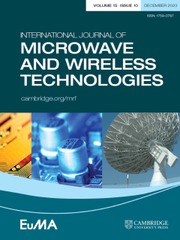Machine learning enabled compact flexible full ground UWB antenna for wearable applications
Published online by Cambridge University Press: 31 October 2024
Abstract
This work introduces a novel compact ultra-wideband (UWB) antenna designed for wearable applications, employing a bioinspired structure and machine learning (ML) techniques to achieve exceptional performance in the 3.10–10.42 GHz range. The antenna is fabricated by positioning conductive fabric on a polydimethylsiloxane polymer of 1 mm thickness to augment high flexibility and durability. Additionally, it pioneers integrating a complete ground plane to mitigate back radiation toward the human body, presenting a compact (35.5 × 30.5 × 1 mm3) UWB antenna design compliant with IEEE 802.15.6 standards. The design methodology includes using bandwidth enhancement techniques such as chamfering edges, slots, and adding stubs in the feed, along with applying ML to optimize the antenna’s dimensions for desired return loss characteristics. The proposed antenna demonstrates exceptional resilience to human body loading and physical deformation. The simulation and measurement results have good agreement. The K-nearest neighbour method beat the other ML algorithms maximum accuracy of 99.62% to predict the S11. According to the author’s best knowledge, this is the first compact UWB antenna with full ground specified by IEEE.802.15.6 with ML reported.
Keywords
- Type
- Research Paper
- Information
- International Journal of Microwave and Wireless Technologies , Volume 16 , Issue 8 , October 2024 , pp. 1303 - 1315
- Copyright
- © The Author(s), 2024. Published by Cambridge University Press in association with The European Microwave Association.
References
- 3
- Cited by



